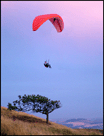|
1,600+Videos! |
||||||||||||||||
 |
||||||||||||||||
|
PG Scot Blog |
||||||||||||||||
|
|
||||||||||||||||
 |
||||||||||||||||
|
|
||||||||||||||||||||||||||||||||
|
Continuing in 2013 to ensure a safer CHOICE always remains available to UK paragliding pilots! |
|
For ‘Safe Regression’ all PG Pilot training should start (from ‘day one’) with a solid base, this base needs to be constantly revised AND expanded as pilot training progresses and must include the following as core subjects:
Items in blue are re-visited in depth each & every training day until the student has both a solid grasp of this aspect of PG aviation (they can quote it with ease) but more importantly for safety the core concepts are well understood. Once the student has an in-depth understanding of each subject, this is checked on each & every flying day by the students demonstrating this core knowledge & understanding to the instructor |
|
Aviation MET: In the case of MET (often the days start point) by giving a quick ‘read’ (de-code to ‘plain English’) of the 214’s, 215’s TAF’s Synoptic Charts as well as the ‘Mark one Eyeball’ assessment of the sky the student will display their current level of MET knowledge & understanding. Students are rapidly expected to start showing a good standard of ‘Weather Awareness’ and will be asked throughout the day as their opinion as to the suitability of continuing flying/training for that day/site. The students judgment should be based on the ‘Mark on Eyeball’ and how that compares with the expectations arising from the various Aviation MET charts/updates. Positive reinforcement is given towards all ‘safety calls’ while expanding the knowledge & understanding of the ‘envelope’... this often involves Murray demo flying to show how quickly things could start to go wrong if a student un-safe ‘call’ is made! Training Time expect at least 10 hours of Aviation MET training and to reach a level that well exceeds that required to pass the a UK PPL MET exam: PG training ‘Day One’ Student will spend about two hours during the day on Aviation MET & HP&L aspects of the training, and on subsequent training days 30mins to one hour (reducing as skills improve) in weather ‘de-code’, assessment and application. |
|
HP&L (Human Performance & Limitations): In the case of aviation training many (many) years ago it was believed that ‘judgment’ could not be taught! However for about half a century in aviation training, especially in military training and to a slightly lesser extent in commercial aviation (paying passengers!) it was discovered that ‘Judgment’ could in fact be taught as part of training provided the required ‘base’ was a core part of training from ‘day one’, this knowledge was gained (and proved) first in military by taking two blocks of pilots and comparing their ‘Judgment’ performance following training, where one group of student pilots had undertaken what is now known as HP&L training and the other pilot group did not get this training but all other aspects of the flight training were identical. Both groups were given a post training ‘blind’ test were they were told the task for the day was ‘X’, a task that had a requirement for certain basic skills that it was reasonable for the student to expect to be tested, BUT in fact was simple the ‘distraction’ from the real testing... during this supposed test ALL pilots (both groups) were asked to alter the flight in a way that was not related to the task but that WAS in some manner un-safe.... it was found that most of the student pilots who HAD undertake HP&L training questioned the alteration and would even refuse a direct order to alter the task in the un-safe manner... while a significant number who had not been given HP&L training WOULD alter the task as they were prepared to presume that the examining Instructor pilot knew what they were doing... A CORE aspect of my PG training is Human Performance & Limitations, it is this in conjunction with Aviation MET and of course Physics that is the principle factor in reducing PG accident rates to a tiny fraction of that seen among ‘normal’ (BHPA Ltd) trained PG pilots. Training Time: As HP&L training ‘overlaps’ many aspects of flight training students should get at least 20 hours of HP&L training and to reach a level that well exceeds that required to pass the a UK HP&L MET exam: |
| [Precision] [Dual Control] [ESP Club] [BHPA V Precision] [Aviation Training] |
